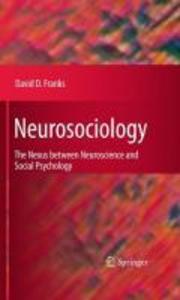
Sofort lieferbar (Download)
As a career sociologist I ? rst became interested in neurosociology around 1987 when a graduate student lent me Michael Gazzaniga s The Social Brain. Ifthe biological human brain was really social, I thought sociologists and their students should be the ? rst, not the last, to know. As I read on I found little of the clumsy reductionism of the earlier biosociologists whom I had learned to see as the arch- emy of our ? eld. Clearly, reductionism does exist among many neuroscientists. But I also found some things that were very social and quite relevant for sociology. After reading Descarte s Error by Antonio Damasio, I learned how some types of emotion were necessary for rational thought a very radical innovation for the long-honored objective rationalist. I started inserting some things about split-brain research into my classes, mispronouncing terms like amygdala and being corrected by my s- dents. That instruction helped me realize how much we professors needed to catch up with our students. I also wrote a review of Leslie Brothers Fridays Footprint: How Society Shapes the Human Mind. I thought if she could write so well about social processes maybe I could attempt to do something similar in connection with my ? eld. For several years I found her an e-mail partner with a wonderful sense of humor. She even retrieved copies of her book for the use of my graduate students when I had assigned it for a seminar.
Inhaltsverzeichnis
The Evolution of the Human Brain. - What Is Social About the Human Brain? . - The New Unconscious: Agency and Awareness. - Mirror Neurons: A Return to Pragmatism and Implications for an Embodied Intersubjectivity. - The Neuroscience of Emotion and Its Relation to Cognition. - The Self in Neuroscience and Social Psychology. - Consciousness, Quale, and Subjective Experience. - The Place of Imitation in Social Life and Its Anatomical Brain Supports. - Determinism and Free Will. - Conclusion.
Produktdetails
Erscheinungsdatum
19. April 2010
Sprache
englisch
Seitenanzahl
216
Dateigröße
2,31 MB
Autor/Autorin
David D. Franks
Verlag/Hersteller
Kopierschutz
mit Wasserzeichen versehen
Produktart
EBOOK
Dateiformat
PDF
ISBN
9781441955319
Entdecken Sie mehr
Pressestimmen
From the reviews:
The intent of this book is to break down `the walls between sociology and neuroscience to the benefit of both . clearly intended for sociological social psychologists. How successful was this book in achieving the relevant depth and comprehensiveness of the issue raised above? Very successful in both respects. this book clearly identifies and explains the pivotal issues in this literature. the author has done an excellent as well as timely job in drawing out these implications. (Paul Tibbetts, The Quarterly Review of Biology, Vol. 86 (3), September, 2011)Bewertungen
0 Bewertungen
Es wurden noch keine Bewertungen abgegeben. Schreiben Sie die erste Bewertung zu "Neurosociology" und helfen Sie damit anderen bei der Kaufentscheidung.









